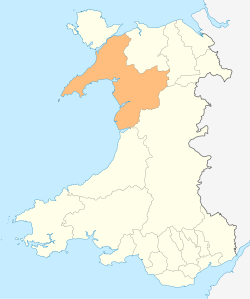| Clwt-y-bont | |
|---|---|
 Caledffrwd Terrace, Clwt y Bont | |
Location within Gwynedd | |
| OS grid reference | SH574630 |
| Community | |
| Principal area | |
| Preserved county | |
| Country | Wales |
| Sovereign state | United Kingdom |
| Post town | CAERNARFON |
| Postcode district | LL55 |
| Dialling code | 01286 |
| Police | North Wales |
| Fire | North Wales |
| Ambulance | Welsh |
| UK Parliament | |
| Senedd Cymru – Welsh Parliament | |
Clwt-y-bont is a village in Gwynedd, Wales, lying just to the south of Deiniolen. The two villages form one urban unit. Both were built in the early 19th century to house workers in the Dinorwig slate quarry, and both suffered when the quarry was closed in 1969.

